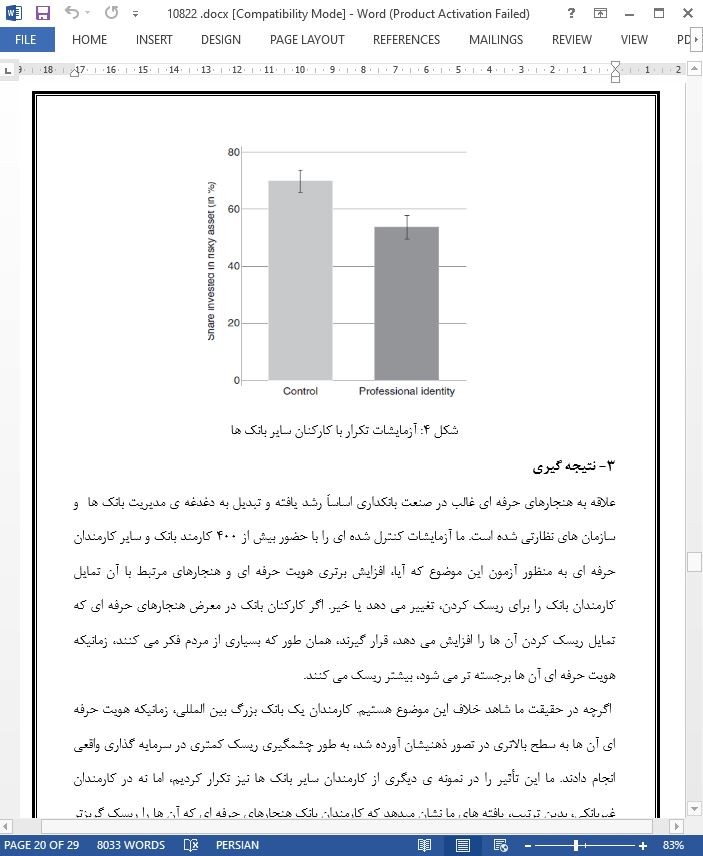
آیا هنجارهای حرفه ای در صنعت بانکداری ریسک پذیری را مطلوب می داند؟
در سال های اخیر، صنعت بانکداری قرابانی موارد بسیاری از ریسک پذیری های مفرط شده است که متعاقباً به هنجارهای حرفه ای مسئله ساز نسبت داده شده اند. ما آزمایشاتی با کارکنان چندین بانک انجام داده ایم که در آن برتری هویت حرفه ای آن ها را دستکاری کردیم و متعاقبا ریسک گریزی آن ها را در شرایطی واقعی سرمایه گذاری، اندازه گیری کردیم . اگر کارکنان بانک در معرض هنجارهای حرفه ای که ریسک پذیری را مطلوب می داند قرار گیرند، زمانیکه هویت حرفه ای آن ها برجسته است، تمایل به ریسک پذیری در آن ها افزایش می یابد. ما دریافتیم که اگرچه، افراد مورد نظر ریسک قابل ملاحظه ی کمتری کردند، این دیدگاه را که هنجارهای حرفه ای عموماً تمایل کارکنان بانک را برای ریسک پذیری افزایش میدهد را به چالش کشیدند.
ریسک های مالی در اغلب فعالیت های تجاری هسته ای بانک ها، نظیر؛ سرمایه گذاری، اعطای وام به افراد، سازمان و دولت ها ذاتی است. اگرچه، در سال های اخیر، حوزه ی ریسک پذیری در صنعت بانکداری به طور گسترده ای مورد سؤال بوده است. به عنوان مثال، اجماعی مشخصی بین دانشگاهیان و مسئولان وجود دارد که ریسک پذیری مفرط در صنعت بانکداری شریک اصلی در بحران مالی جهانی است.موضوع ریسک پذیری مفرط منجر به مباحث فعالی میان سیاست گذاران و مسئولان درباره ی ریشه های احتمالی آن شده است. بسیاری معتقدند که هنجارهای حرفه ای غالب ، دیدگاه هایی درباره رفتار قابل قبول است که به طور مشترک میان اعضای یک شغل خاص به طور گسترده وجود دارد، ریسک پذیری مفرط توسط ایجاد کارکنان ریسک گریزتر. در نتیجه سیاست گذاران و مسئولان برای تغییر هنجارهای حرفه ای در تلاش برای شناسایی مشکل ریسک پذیری مفرط فراخوانده شده اند.اما دانش تجربی در مورد اینکه آیا هنجارهای حرفه ای در صنعت بانکداری ریسک گریزی کارکنان را کاهش می دهد یا نه، ناچیز است.
۳- نتیجه گیری
علاقه به هنجارهای حرفه ای غالب در صنعت بانکداری اساساَ رشد یافته و تبدیل به دغدغه ی مدیریت بانک ها و سازمان های نظارتی شده است. ما آزمایشات کنترل شده ای را با حضور بیش از ۴۰۰ کارمند بانک و سایر کارمندان حرفه ای به منظور آزمون این موضوع که آیا، افزایش برتری هویت حرفه ای و هنجارهای مرتبط با آن تمایل کارمندان بانک را برای ریسک کردن، تغییر می دهد یا خیر. اگر کارکنان بانک در معرض هنجارهای حرفه ای که تمایل ریسک کردن آن ها را افزایش می دهد، قرار گیرند، همان طور که بسیاری از مردم فکر می کنند، زمانیکه هویت حرفه ای آن ها برجسته تر می شود، بیشتر ریسک می کنند.
In recent years, the banking industry has witnessed several cases of excessive risk-taking that frequently have been attributed to problematic professional norms.We conduct experiments with employees from several banks in which we manipulate the saliency of their professional identity and subsequently measure their risk aversion in a real stakes investment task. If bank employees are exposed to professional norms that favor risk-taking, they should become more willing to take risks when their professional identity is salient. We find, however, that subjects take significantly less risk, challenging the view that the professional norms generally increase bank employees’ willingness to take risks.
Financial risks are inherent in most banks’ core business activities, such as investing and lending money to individuals, organizations, and governments. In recent years, however, the extent of risk-taking in the banking industry has been widely questioned. For example, there is an emerging consensus among academics and regulators that excessive risk-taking in the banking industry was a major contributor to the global financial crisis (e.g., Diamond and Rajan 2009; Financial Crisis Inquiry Commission 2011; Freixas and Dewatripont 2012). The issue of excessive risk-taking has led to active discussions among policy makers and regulators about its possible roots. Many believe that the prevailing professional norms—that is, views about acceptable behavior that are widely shared among members of a specific profession—favor excessive risk-taking by making employees less risk averse. Consequently, policy makers and regulators have called for a change in professional norms in an attempt to address the problem of excessive risk-taking (e.g., House of Commons Treasury Committee 2008; Power, Ashby, and Palermo 2013; International Monetary Fund 2014). But empirical knowledge about whether the professional norms in the banking industry reduce employees’ risk aversion has proven elusive.
3. Conclusion
Interest in the professional norms prevailing in the banking industry has grown substantially and continues to preoccupy the leadership at banks and regulatory agencies. We conducted controlled experiments with more than 400 bank employees and other professionals to examine whether an increase in professional identity saliency and associated norms changes bank employees’ willingness to take risks. If bank employees are exposed to professional norms that increase their risk appetite, as many people think, they should become more willing to take risks when their professional identity is made salient.

1- طراحی تجربی
2- نتایج تجربی
۱-۲- بررسی دستکاری
۲-۲-آزمایش اصلی با شرکت کارکنان بانک بزرگ بین المللی
۳-۲- آزمایشات کم اهمیت(فرعی) با کارکنان غیر بانکی
۲-۴- آزمایشات تکراری با مشارکت کارمندان سایر بانک ها
۳- نتیجه گیری
1.Experimental Design
2. Experimental Results
2.1 Manipulation check
2.2 Main experiment with employees of a large international bank
2.3 Placebo experiment with nonbanking employees
2.4 Replication experiment with employees from other banks
3. Conclusion
- اصل مقاله انگلیسی با فرمت ورد (word) با قابلیت ویرایش
- ترجمه فارسی مقاله با فرمت ورد (word) با قابلیت ویرایش، بدون آرم سایت ای ترجمه
- ترجمه فارسی مقاله با فرمت pdf، بدون آرم سایت ای ترجمه
